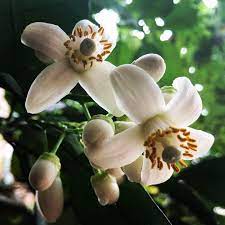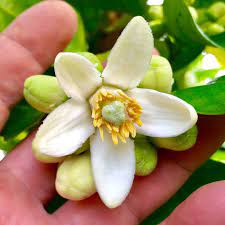Grapefruit flowers, also known as Citrus paradisi flowers, are the blossoms of the grapefruit tree, a member of the citrus family. These flowers are delicate, fragrant, and an essential part of the grapefruit tree’s reproductive cycle.
Grapefruit flowers are small and typically white in color. They have five petals arranged in a star-like shape. The flowers are about 1 to 1.5 inches (2.5 to 3.8 cm) in diameter.mThe fragrance of grapefruit flowers is sweet, citrusy, and reminiscent of the grapefruit’s characteristic aroma. The scent is fresh, uplifting, and often used in perfumes and aromatherapy.
Grapefruits trees typically bloom in the spring, producing clusters of flowers on the branches. The blooming period may extend for several weeks, and the flowers attract bees and other pollinators. Grapefruit flowers emerge from the leaf axils or the end of branches, growing in clusters. These clusters can range from a few flowers to several dozen, adding a beautiful aesthetic to the tree.
Grapefruits flowers contain both male and female parts. The male parts, known as stamens, produce pollen. The female part, the pistil, consists of the stigma, style, and ovary, where the fruit will develop if pollination is successful. Grapefruit flowers rely on bees and other insects for pollination. Bees are particularly important for transferring pollen from the stamens to the pistil, enabling fruit production.
Successful pollination leads to the development of grapefruits. Each fertilized flower results in a grapefruit, which starts as a small, green fruit and gradually matures into the familiar yellow or pink grapefruit we commonly consume. In addition to their role in fruit production, grapefruits flowers are also appreciated for their beauty and fragrance, making them a delightful addition to gardens and orchards.
The Economic Importance and Uses of Grapefruit Flowers

Grapefruit flowers, like those of many citrus plants, have several economic and practical uses, although they are not as widely utilized as other parts of the grapefruit tree, such as the fruit itself.
Here are the economic importance and uses of grapefruit flowers:
1. Ornamental and Landscaping Purposes: Grapefruits flowers are prized for their aesthetic appeal and sweet fragrance. They are used in landscaping and ornamental gardening to enhance the beauty of gardens, parks, and other outdoor spaces.
2. Perfumery and Fragrance Industry: Grapefruits flowers contribute to the production of essential oils, absolutes, and fragrances used in perfumery and aromatherapy. The essential oil extracted from grapefruit flowers is valued for its citrusy and refreshing scent, making it a popular ingredient in perfumes, colognes, and scented products.
3. Floral Arrangements and Decorations: Grapefruits flowers are used in floral arrangements and bouquets, adding a touch of elegance and a pleasant fragrance. Florists use grapefruit flowers to create stunning and aromatic displays for various occasions, including weddings, events, and special celebrations.
4. Culinary and Beverage Applications: The petals of grapefruit flowers can be used as a garnish in salads, desserts, and various culinary dishes. Additionally, grapefruit flowers can infuse beverages such as teas, cocktails, or infused water with a subtle citrus flavor and aroma.
5. Medicinal and Herbal Uses: Grapefruit flower extracts may have potential health benefits, including antioxidant properties and potential anti-inflammatory effects. In traditional medicine, grapefruit flowers have been used for their perceived medicinal properties, although further research is needed to confirm these potential benefits.
6. Beekeeping and Honey Production: Grapefruit flowers provide nectar and pollen for bees, supporting beekeeping and honey production. Beekeepers place their hives near citrus orchards to allow bees to forage on the flowers, ultimately contributing to honey production and pollination of other crops.
7. Essential Oil Production: Grapefruit flowers are a source of grapefruit flower essential oil, which is extracted through a distillation process. This essential oil is used not only in perfumery but also in the manufacturing of skincare and haircare products due to its refreshing and rejuvenating properties.
Read Also; Currant Flowers: Economic Importance, Uses and By-Products
8. Agricultural and Horticultural Practices: The cultivation of grapefruit flowers helps support the overall health and growth of grapefruit trees. Healthy flowers lead to healthy fruit production, contributing to the economic success of grapefruit orchards and farms.
9. Flavoring and Aromatizing Food and Beverages: Some culinary applications involve using grapefruit flowers to infuse flavor into dishes, desserts, and beverages. The petals can be steeped in liquids to add a delicate citrusy aroma and taste to recipes. This application is more common in some traditional cuisines.
10. Natural Dyes and Coloring: Grapefruit flowers can be used as a source of natural dyes and colorants for fabrics and food products. The petals can yield various shades of yellow and orange when used in dyeing textiles or as a natural food coloring.
11. Herbal Teas and Tisanes: Dried grapefruit flower petals are sometimes used to make herbal teas or tisanes. These teas may have a mild, citrusy flavor and are often consumed for their perceived health benefits and soothing properties.
12. Crafts and Artistry: Artists and craft enthusiasts may use dried grapefruit flowers in various creative projects, such as making potpourri, scented sachets, or decorative arrangements. The flowers’ pleasing fragrance and appearance make them suitable for artistic endeavors.
13. Research and Development: Grapefruit flowers are of interest to researchers and scientists studying citrus genetics, horticulture, and plant biology. Studying the flowers can contribute to advancements in citrus cultivation and breeding, potentially leading to improved fruit varieties.
The Products and By-products That Can Be Derived From Grapefruit Flowers
Grapefruit flowers, like other citrus blossoms, can be utilized to produce a variety of products and by-products. These can range from culinary uses to cosmetics and fragrances.
Here’s a list and explanation of potential products and by-products derived from grapefruit flowers:
1. Essential Oil: Extraction of essential oil from grapefruit flowers is a common practice. Grapefruit flower essential oil has a sweet, floral, and citrusy aroma. It’s used in aromatherapy, perfumes, and as a flavoring agent.
2. Hydrosol: Hydrosol is the by-product of the steam distillation process used to extract essential oil. Grapefruit flower hydrosol is a mild, aromatic water and is used in skincare products, room sprays, and as a base for some natural perfumes.
3. Infused Oil: Infusing a carrier oil with grapefruit flowers can create an aromatic oil that can be used in massage oils, bath products, or as a base for perfumes and lotions.
4. Tea and Herbal Infusions: Dried grapefruit flowers can be used to make teas and herbal infusions. These teas are known for their delicate floral and citrus flavors, and they can be enjoyed hot or cold.
5. Culinary Flavoring: Grapefruit flowers can be used to infuse culinary dishes, desserts, or beverages, imparting a subtle citrus and floral flavor.
Read Also: Grapefruit Lenticels: Economic Importance, Uses And By-Products
6. Potpourri and Sachets: Dried grapefruit flowers can be used in potpourri or placed in sachets to add a pleasant fragrance to drawers, closets, or rooms.
7. Bath Products: Grapefruit flower extracts can be used in bath salts, bath oils, or bath bombs to provide a relaxing and aromatic bathing experience.
8. Skincare Products: Extracts from grapefruit flowers can be incorporated into skincare products like lotions, creams, and toners due to their potential skin-beneficial properties.
9. Perfumes and Fragrances: Grapefruit flower essential oil is a popular ingredient in perfumes and fragrances, contributing to its unique citrusy and floral notes.
10. Floral Water: Grapefruit flower water or floral water can be obtained through a steam distillation process. It’s used in skincare and as a refreshing facial mist.
11. Bioactive Compounds for Pharmaceuticals: Grapefruit flowers may contain bioactive compounds with potential medicinal properties. These compounds could be extracted and used in pharmaceutical products.
12. Natural Dyes: Grapefruit flowers can be used to create natural dyes for fabrics and other materials, producing a range of yellow to pinkish hues.
In conclusion, these products and by-products demonstrate the diverse uses and applications of grapefruit flowers, from aromatherapy to culinary enhancements and beyond. Always ensure proper harvesting and processing practices to maintain the quality and effectiveness of the derived products.

